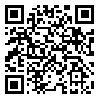Volume 31, Issue 1 (3-2024)
RJMS 2024, 31(1): 1-9 |
Back to browse issues page
Research code: 01
Ethics code: IR.IAU.SARI.REC.1403.370
Clinical trials code: 01
Download citation:
BibTeX | RIS | EndNote | Medlars | ProCite | Reference Manager | RefWorks
Send citation to:



BibTeX | RIS | EndNote | Medlars | ProCite | Reference Manager | RefWorks
Send citation to:
Kavan M, Zameni F, Enayati T. Providing a Web-Based Learning Model for Decision-Making Self-Efficacy Among Students of Mazandaran University of Medical Sciences. RJMS 2024; 31 (1) :1-9
URL: http://rjms.iums.ac.ir/article-1-8069-en.html
URL: http://rjms.iums.ac.ir/article-1-8069-en.html
Associate Professor, Department of Educational Management, Faculty of Humanities, Sari Branch, Islamic Azad University, Sari, Iran , f_zameni@yahoo.com
Abstract: (475 Views)
Background & Aims: Web-based learning, as an innovative educational approach, provides students with access to extensive resources, diverse educational interactions, and personalized learning opportunities. This method utilizes digital technologies to offer flexible learning anytime and anywhere, while multimedia tools and learning management systems make the learning process more interactive and effective. Medical students, due to the specialized and complex nature of their field, require methods that not only enhance their theoretical knowledge but also improve their clinical decision-making abilities. Decision-making self-efficacy, as a key factor in the academic and professional success of these students, can be influenced by modern educational approaches. Web-based learning, by providing virtual learning environments, clinical simulations, adaptive assessments, and intelligent decision-support systems, can play a crucial role in boosting confidence and the ability to analyze clinical situations. However, challenges such as the need for self-regulation, limitations in practical training, and dependence on digital infrastructure must be considered for the effective implementation of this method. Medical students, given the professional nature of their field, need to make precise, rapid, and well-informed decisions. They must be able to analyze scientific data and make optimal choices that directly impact patient health and the quality of medical services. Therefore, decision-making self-efficacy, as one of the most critical factors in their success, plays a key role in their academic and professional performance. Decision-making self-efficacy refers to an individual’s belief in their ability to make accurate and effective decisions and can be influenced by various educational methods. Despite the high importance of this subject, limited research has explored the relationship between web-based learning and decision-making self-efficacy among medical students. Many traditional educational methods used in medical universities are still based on face-to-face, instructor-centered teaching, which may not provide students with sufficient opportunities for critical thinking, problem-solving, and independent decision-making. In contrast, web-based learning, by offering interactive learning environments, medical simulations, adaptive assessments, and virtual clinical scenarios, can create an effective platform for enhancing students’ decision-making skills. Given the significance of decision-making self-efficacy in the learning process and professional performance of medical students, this study aims to develop a web-based learning model and examine its impact on improving decision-making self-efficacy. The goal of this study is to design and propose an educational model that, through online tools and modern educational technologies, can guide students toward more active learning, more informed decision-making, and greater confidence in their academic and professional choices.
Methods: The study employed a mixed-methods approach (qualitative and quantitative). The statistical population in the qualitative section included 20 expert faculty members from Mazandaran University of Medical Sciences and Farhangian University, specializing in the research subject. In the quantitative section, the population comprised 3,719 postgraduate students and medical residents from Mazandaran University of Medical Sciences. A purposive sampling method was used in the qualitative phase, selecting 14 participants, while in the quantitative phase, Cochran’s formula was applied, resulting in a sample size of 384 participants. Data were collected using a researcher-made Web-Based Learning questionnaire and the Betz and Luzzo Professional Decision-Making Self-Efficacy questionnaire. Data analysis was conducted using structural equation modeling with SPSS21, PLS3.2, and MAXQDA2020 software.
Results: The results indicated that, according to experts, the Web-Based Learning questionnaire consisted of six dimensions ranked as follows: educational infrastructure, teaching and learning methods, assessment, learning environment, and resource support. Furthermore, the impact of web-based learning on students' decision-making self-efficacy at Mazandaran University of Medical Sciences was confirmed based on significant factor loadings.
Conclusion: The findings of this study demonstrated that web-based learning significantly influences medical students' decision-making self-efficacy through key dimensions such as educational infrastructure, teaching and learning methods, assessment, learning environment, and resource support. Data analysis revealed that this educational approach, by providing a flexible and interactive learning environment, can enhance students’ decision-making skills. Moreover, the significance of factor loadings confirmed the positive impact of this model. The study underscores the importance of developing and optimizing web-based learning in medical education and suggests that universities strengthen their digital infrastructure and design efficient educational programs to utilize this method as an effective tool for improving students’ decision-making capabilities. However, some challenges associated with web-based learning may negatively affect decision-making self-efficacy. For instance, some students may feel overwhelmed by the vast amount of information or experience a sense of isolation due to the lack of face-to-face interactions. Additionally, time management in online learning poses a significant challenge, which, if not properly addressed, could reduce productivity and lead to a sense of inefficacy. Nevertheless, if students develop self-regulation and time management skills, they can overcome these challenges and fully benefit from web-based learning. Overall, web-based learning, due to its flexibility, accessibility to vast resources, opportunities for interaction, rapid feedback, and diverse teaching methods, can positively influence students’ decision-making self-efficacy. This educational method helps students strengthen their cognitive and analytical skills, gain greater confidence in their decision-making abilities, and ultimately achieve better academic and professional performance.
Type of Study: Research |
Subject:
Clinical Psychiatry
Send email to the article author







